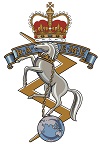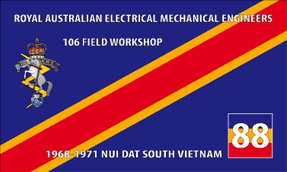1968
Preparing for Patrolling
and Sector Defence Missions
Milton C. W. Pearson, the CSM of 106 Field Workshop, 1968-1969
The Unit was placed under command of 4 Bn RAR for Area of Operations patrolling. In another article I spoke of getting myself acquainted with their patrolling procedures and techniques
Additionally the Unit was under orders to provide Task Force Operational Base Sector defence personnel for other units when their F and A echelons were operating from Fire Support Bases or Forward Operational Bases elsewhere in the theatre of operations.
Even though the Unit was just forming and was heavily loaded, I had to find the ways and means to quickly get members of the Unit up to speed so that we could undertake these missions successfully, securely and with confidence.
Resources
Although every RAEME soldier was trained in infantry minor tactics, most had only limited experienced in its application. Their technical trade skills, however, provided a rich resource for quickly producing people for staffing patrols, particularly key positions. I tried to make maximum use of each persons own strength and weakness or perceived weaknesses and their physical attributes, for example,
- Radio operators for the ANPRC25 were drawn from the Radio Mechanics
- Machine gunners for the GPMG M60 were filled by Armament Fitters
- Soldiers of short stature were selected for forward scout training
This enabled the training for particular positions to be concentrated on selected individuals. Proficiency had to be, and was, achieved with the least distraction from the Unit's primary mission and speedily
Training
Training and rehearsal in infantry minor tactics was carried out in the open space in rear of the accomodation lines. Weapon standards were checked and improved on the Task Force firing range or using the Cavalry Squadron's test pit. The .30 and .50 cal range shoot went down well. I set up 44gal drums some 600m away with the weapons set up on the Fitters Track and conducted a shoot firing some 8000 rounds of ammunition. Most of this ammunition was not in pristine condition. However, I put it to good use and the firing was a real morale booster.
Nightly harbouring I taught on the job, whereby I would take a patrol out and the person selected to be the next Patrol Commander would be part of the patrol and learn on the job also.
I used a triangular harbour with the apex of the triangle facing the most likely approach and here the GPMG60 was sighted. The other two points of the triangle were where other members of the group were located. The Patrol Commander was in the centre with the Radio Operator. When you wanted zero movement in the harbour you simply doubled the numbers on the M60; with a sleep rotation in place there was no need to go and wake the next shift because the change over crew was already there.
New to many was the M18A1 Anti Personnel Mine "Claymore", you know the ones, some 700 ball bearings packed in beeswax with a writing on the convex side saying "front towards the enemy". They were electrically detonated on command using a hand held dynamo and cable.
Teaching this task was not difficult. With every six mines a test firing device (the M57 from memory) was part of the issue. The sighting was simply looking through a peep aperture and adjusting the angle of the mine from the metal legs that formed the mines base. To check the cabling for continuity the tester was connected at the mine end. When the dynamo was activated the test device absorbed the current and illuminated if all was well. The tester was then simply removed. The clacker was then ready.
I did fire a few on the range and the men certainly gained confidence from seeing the results of the targets that I set up for the demonstration and what they looked like after a mine explosion
Maps were obtained from 1 Topographical Survey Troop, cut down and water proofed.
Very few soldiers missed out on a TAOR patrol, regardless of their trade.
Additional Sector Defence Duties
As I mentioned when the Task Force was operating forward, fighting units would be thin on the ground at the Task Force Operational Base. We regularly had to supply Sector defence at night for the armoured squadron and for a US self propelled artillery battery, "Huskey Alpha", equipped with track mounted 155mm and 175mm guns, which was under command of 1ATF, based at Nui Dat but invariably at some far distant Fire Support Base (FSB).
This required that I be thoroughly conversant with their Sector defences so that responsibility could be transferred smoothly, and my own teams briefed and placed
In the Huskey Alpha position it was impossible not to notice the many wire cables lying all over the place. This cabling was for the M18A1 Anti Personnel Mines
In connection with B Sqn there was an incident I could never forget.
After being briefed at their Command Post (CP) on the extent and location of night duties I was returning to 106 when I heard firing from a Centurion Tank. For some reason I looked up just in time to see a large object coming straight at me. I leapt back and the object landed at my feet. On stooping to pick it up, I found the metal to be quite hot. It turned out to be an outer casing from a canister round.
What happened was that, after the briefing at the CP, an Corporal tank commander, returning to his tank to brief the non regular occupants on their task for a night duty, fired the gun in demonstration. Not known to the Corporal, there was a canister in the breach and "woompa" off she went. The barrel of the centurion was pointed skywards back towards the CP and the canister simply wiped out their communication wires. An unsuspecting Officer coming towards me copped my full repertoire. It was the first and last time I abused an Officer. No excuses, he was the Officer who conducted the briefing. No names no pack drill; well it was a Captain. Today, I can still visualise that piece of space junk coming towards me. Of the Corporal, I found out his name in the early nineties.
Cpl J (Fred) Fedorowytsch comments
I would like to amend your last paragraph just a little, as I was that infamous Corporal Tank Commander.
Firstly there was a shortcoming in the training of our troops, they should have been taught how to fire the main gun prior to posting to SVN, however be that as it may let us continue. The captain that you abused was probably our 2/ic Capt Jim Hull.
Secondly, there was a stack of DVR's (defective vehicle report) both elec., and mech., but due to pressures of tasks we were low on the call in list. From here the sequence of events went as follows;
- Everyone got in the tank and as I was last to get on board I ensured that the MASTER SWITCH was OFF.
- Gun fully elevated, all hands,arms and legs out of harms way.
- Then I taught them to correctly identify a HE and Canister round and the correct way of loading.
- Then followed the firing sequence, loaders safety switch, gunners selector switch and firing switch. On about the fourth run through I recall saying "if the master switch was on and as you select main this red light would come on" then in your word "woompa".
- The formal investigation found the master switch to be faulty
Just for info the rounds are electricly initiated and not precussion cap fired. It takes just 0.5amp to set it off.
You should have come in and seen the rubber trees, man did they get a hair cut.
Regards Fred

